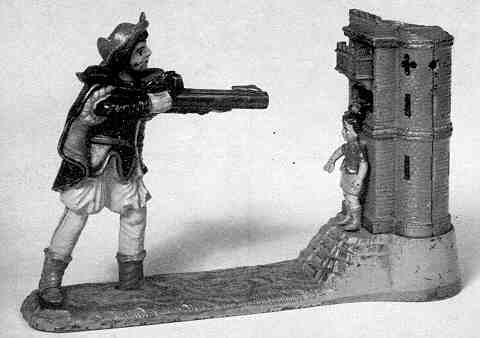William Tell Bank
by F.H. Griffith - HOBBIES Magazine - September, 1974

Sometime ago the writer mentioned in one of the articles that certain of the more common banks were among the most interesting and attractive of the mechanicals. This is certainly true and as we reach No. 239 in the numerical classification, our choice of the William Tell Bank proves our point quite well. It is a very attractive bank with excellent action and subject matter. The coin taking part in the action, in this case representing an arrow, is a particularly desirable feature. Every aspect of the William Tell Bank makes it one of the great mechanicals and certainly it is anything but a rare bank. Rarity naturally is a big factor in collecting mechanical banks and increasingly so as the collector becomes more advanced. At the same time most of us are inclined, as we move along, to lose sight of an appreciation of the really great mechanicals that are in the more common category.
The William Tell enjoyed tremendous popularity over the many years it was manufactured. It had great appeal to the general public and in its period was the type toy that many parents would buy for their child. It appealed to grownups then as it does now, different today only from the collecting angle. In other words, the same appeal is there, but now it has become a collector’s item. As a collector’s item it is one of the more easily obtained mechanicals and this is due, of course, to its wide acceptance over a period of years and the large quantity that were made to fill this acceptance. Also because of this it is one of the mechanicals that can be found in fine to so called mint condition more readily than most.
The William Tell was designed by Russell Frisbie of Cromwell, Conn., and patented by him under a design patent June 23, 1896. He assigned his design patent covering the bank to the J. & E. Stevens Company, also of Cromwell. The design drawings are practically identical to the bank as manufactured by Stevens. The text of the patent accurately describes the bank and refers to the shooting figure as being that of William Tell. Defining the figure is more unusual than usual. Design patents are more apt to be specific as to the overall configuration as compared to regular patents. Some mechanicals were covered by both design and regular patent. Generally speaking, however, with respect to regular patents the figure or figures were left in an area of flexibility so that broader coverage was obtained and different figures could be used if so decided when the time came to manufacture the respective banks.
Certainly the story of William Tell is known by everybody and their aunt, so it would seem completely unnecessary to go into detail on that score. In any case, the bank well represents the climax of the story and William does a good job of knocking the apple from his son’s head.
The bank shown is in extra fine, all original condition, and colors are as follows: The base is light green with gold highlighting, the castle is light tan with parts of the structure in gold and black. The boy has a yellow apple on top of his black hair. He wears a red jacket, yellow skirt and yellow boots. Face, arms and knees are light flesh color. William Tell wears a gray hat with red plume and he has the same flesh color face and hands as the boy. His hair, cape and gun are black. The cape has a khaki collar and red lining. His shirt or tunic is black with yellow ruffle sleeves and red belt and edging. He has yellow and cream breeches with khaki boots. Good coloring adding up to a handsome bank.
To operate, the odd shaped piece on the gun barrel is pressed back where it snaps into position as the head of William Tell lowers, taking aim. A coin is placed on top of the barrel just in front of this piece. The boy’s right arm is pulled down bringing the apple to the top of his head. Then the right foot of William Tell is pressed down. This fires the gun and the coin shoots forward knocking the apple from the boy’s head as he raises his right arm and a bell inside the castle rings. The head of William Tell goes back into position as in the photo. The gun is made in such fashion that a paper cap may be used, and if so it is fired during the action.
The patent date June 23, 1896 is cast in raised letters on the underside of the base. The conventional round Stevens coin trap is under the castle in the base plate.
